 Last additions - NARA 奈良県 Last additions - NARA 奈良県 |

Roof tile used in the reconstruction.May 30, 2010
|
|

Paintings on the ceiling.May 30, 2010
|
|

Paintings on the ceiling.May 30, 2010
|
|

The ceiling has hand-painted flowers.May 30, 2010
|
|

Life-size model of the Shibi ornament atop the roof's ridge.May 30, 2010
|
|

They had a large stage out front on the day I visited and these ribbons attached to the building.May 30, 2010
|
|

The Daigokuden Hall's front gate, called Suzaku Gate, can be seen.May 30, 2010
|
|

Behind the Takamikura Throne.May 30, 2010
|
|

We could also go outside on the balcony and see a good view.May 30, 2010
|
|

It looks like a portable shrine.May 30, 2010
|
|

Phoenix atop the Takamikura Throne.May 30, 2010
|
|

Design pattern on the Takamikura Throne panels.May 30, 2010
|
|

Top of the Takamikura ThroneMay 30, 2010
|
|

Takamikura Throne where the emperor sat when there was an audience.May 30, 2010
|
|
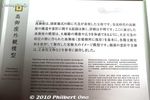
About the Takamikura Throne in English.May 30, 2010
|
|

Takamikura ThroneMay 30, 2010
|
|

This thing is so nice that they should get a real emperor's coronation or enthronement here someday.May 30, 2010
|
|

About the excavation of Former Imperial Audience Hall in English.May 30, 2010
|
|

About the Former Imperial Audience Hall in English.May 30, 2010
|
|

About the Former Imperial Audience Hall in English.May 30, 2010
|
|

Panel displays explaining about the Former Imperial Audience Hall.May 30, 2010
|
|

Inside the Former Imperial Audience Hall. In the center was the Emperor's Takamikura Throne.May 30, 2010
|
|

On the railing are decorative jewel balls in different colors. May 30, 2010
|
|

But now, anyone can enter this reconstruction for free. There was a long line, but it proceeded quickly and it took only 10-min. or so to get in.May 30, 2010
|
|

On the balcony of the Former Imperial Audience Hall before entering the building through a side entrance.May 30, 2010
|
|

On the railing are decorative jewel balls in different colors. May 30, 2010
|
|

This was the center of the capital and symbol of state authority. Only high-ranked aristocrats were allowed to enter the Daikokuden Hall.May 30, 2010
|
|

I took this Kintetsu Line train at Kyoto Station. You should also bring your passport which will enable you to enter a few Heijo-kyo attractions for free.May 30, 2010
|
|

The Daigokuden Hall (Former Imperial Audience Hall) is a magnificent reconstruction. This was where the emperor performed his duties during the Nara Period. 大極殿May 30, 2010
|
|

This is the heart of the Heijo Palace site. The focal point is the Daigokuden Hall (Former Imperial Audience Hall) in the distance. 大極殿・前庭May 30, 2010
|
|

I went during Golden Week when they had flowers and various events and entertainment. I recommend visiting here on a weekend or holiday period. That's when they have more events and entertainment. The crowds are not unbearable.May 30, 2010
|
|

It was 1,300 years ago in 710 when Japan's capital was moved to this place in Nara. Hence, the 1300th anniversary celebration in 2010.May 30, 2010
|
|

Path toward the central area. The Daigokuden Imperial Audience Hall is in the distance on the left. This Heijo-kyo area is a National Special Historic Site.May 30, 2010
|
|

Arrows and Sento-kun point the way. Or just follow the crowd.May 30, 2010
|
|

I arrived at Yamato Saidaiji Station which is within walking distance to the Heijo-kyo site. You can also go to JR Nara Station and ride a free shuttle bus to the Heijo Palace site.May 30, 2010
|
|

I first heard about Nara's 1300th anniversary a few years ago through this mascot named Sento-kun. A boy priest with deer antlers was so absurd that he has become very popular and recognizable.May 30, 2010
|
|

Only 10 torches are lit. Most photos show a time-lapse shot which lights up the entire hall. Tripod required though, and you need to be a press photographer.Mar 08, 2007
|
|

The torch walk ends in 20 min. Police and firemen are present.Mar 08, 2007
|
|
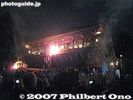
The priest runs while spinning the torch on the balcony. Also see the video at YouTube.Mar 08, 2007
|
|
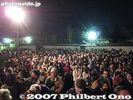
Large crowd behind us. Tripods are not allowed.Mar 08, 2007
|
|
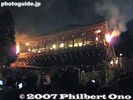
The torch is positioned at the corners. It is totally dark when the torches are lit.Mar 08, 2007
|
|
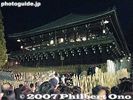
Every evening during March 1-14, Todaiji temple priests carry torches on the balcony of Nigatsu-do Hall. Sparks falling from the torches bring good health. Todaiji temple 二月堂Mar 08, 2007
|
|

Horyuji Station platformMar 07, 2007
|
|

Mar 07, 2007
|
|

Horyuji Station, under construction in Mar. 2007 法隆寺駅Mar 07, 2007
|
|

Bus stop in front of Horyuji Station. Takes you to the temple.Mar 07, 2007
|
|

Bell tower in East Precinct 東院鐘楼Mar 07, 2007
|
|

Horyuji temple, Yumedono Pavilion, National Treasure. The Nippon Budokan martial arts hall in Tokyo was designed after this pavilion. 夢殿Mar 07, 2007
|
|

Yumedono Pavilion, National Treasure dedicated to Shotoku Taishi. Built on the site of Prince Shotoku's palace. 夢殿Mar 07, 2007
|
|

Bell tower in East Precinct 東院鐘楼Mar 07, 2007
|
|

Path to Yumedono PavilionMar 07, 2007
|
|

Ticket gate to Yumedono. Admission included in the 1,000 yen ticket.Mar 07, 2007
|
|

Path to Yumedono PavilionMar 07, 2007
|
|

National TreasureMar 07, 2007
|
|

Tōdaimon Gate, National Treasure 東大門Mar 07, 2007
|
|

Chūmon Gate, National Treasure 中門Mar 07, 2007
|
|

東院鐘楼Mar 07, 2007
|
|

Signs to other templesMar 07, 2007
|
|

Corridor and Chūmon Gate 西院伽藍の廻廊Mar 07, 2007
|
|

Hall of Paintings has the Illustrated Biography of Prince Shōtoku (National Treasure), masterpiece 11th century wall painting depicting Shotoku Taishi's life episodes bordering on legend and myth since he was later revered as a Buddha by Horyuji. �Mar 07, 2007
|
|

Horyuji temple, Daikōdō Hall, National Treasure 大講堂Mar 07, 2007
|
|

Hall of Paintings. The original painting is preserved at Tokyo National Museum. Official video of the painting: https://youtu.be/sJB-03HQMNA 国宝 聖徳太子絵伝 絵殿、舎利殿Mar 07, 2007
|
|

Path to Yumedono PavilionMar 07, 2007
|
|

Chūmon Gate, National Treasure 中門Mar 07, 2007
|
|

Gate to Yumedono PavilionMar 07, 2007
|
|

Mar 07, 2007
|
|

Daiho-zoin Museum. Admission included in the 1,000 yen ticket. 大宝蔵院Mar 07, 2007
|
|

Daiho-zoin Museum 大宝蔵院Mar 07, 2007
|
|

Daikōdō Hall, National Treasure. Houses Buddha statues. 大講堂Mar 07, 2007
|
|

Mar 07, 2007
|
|

Mar 07, 2007
|
|

Kondo Main Hall, National Treasure. It has some Chinese design elements. 金堂Mar 07, 2007
|
|

Chūmon Gate and Kondo HallMar 07, 2007
|
|

Even the corridor is a National Treasure. Has about 150 wooden pillars. 西院伽藍の廻廊Mar 07, 2007
|
|

Mar 07, 2007
|
|

Mar 07, 2007
|
|

Lantern reliefMar 07, 2007
|
|

LanternMar 07, 2007
|
|

Kondo Main Hall houses 13 Buddha statues. 金堂Mar 07, 2007
|
|

Mar 07, 2007
|
|

To Daikōdō HallMar 07, 2007
|
|

Daikodo Hall and Five-Story Pagoda, National Treasures 五重塔Mar 07, 2007
|
|

Kondo Main Hall, National Treasure 金堂Mar 07, 2007
|
|

Kondo Main Hall, National Treasure 金堂Mar 07, 2007
|
|

Mar 07, 2007
|
|

Horyuji temple Kondo Main Hall, the world's oldest wooden building at 1,300 years old. National Treasure 金堂Mar 07, 2007
|
|

Kondo Main Hall, National Treasure and Horyuji's most important building. However, on January 26, 1949, much of the first floor was destroyed by accidental fire. 金堂Mar 07, 2007
|
|

Goju-no-To (Five-Story Pagoda), National Treasure, Horyuji. The size of the roof gets smaller toward the top of the structure. 五重塔 仏舎利Mar 07, 2007
|
|

Mar 07, 2007
|
|

Mar 07, 2007
|
|

You can enter or see inside the buildings, but no photography is allowed inside.Mar 07, 2007
|
|

Mar 07, 2007
|
|

Horyuji Goju-no-To (Five-Story Pagoda) National Treasure. Houses a few bones of Shakyamuni Buddha. 五重塔Mar 07, 2007
|
|

三経院 National TreasureMar 07, 2007
|
|

The Five-Story pagoda has a thick wooden pillar in the center going from the bottom to the top. Only the top part of the building is in contact with the central pillar and works to counterbalance earthquake swaying.Mar 07, 2007
|
|

Five-Story Pagoda and Kondo Hall, National Treasures 五重塔 金堂Mar 07, 2007
|
|

Mar 07, 2007
|
|

Mar 07, 2007
|
|

Horyuji temple Five-Story Pagoda and Kondo Hall, National Treasures 五重塔 金堂Mar 07, 2007
|
|

Mar 07, 2007
|
|

Sai-in Garan West Precinct 西院伽藍Mar 07, 2007
|
|

Horyuji and World Heritage Site (Japan's first) markerMar 07, 2007
|
|

Map of Horyuji. Large complex of buildings. Only two precincts are open to the public.Mar 07, 2007
|
|

Horyuji temple, Nandaimon Gate, National Treasure 南大門(国宝)Mar 07, 2007
|
|

西院伽藍Mar 07, 2007
|
|

Founded in 607 by Prince Shotoku Taishi, Horyuji is one of Japan's most famous temples, with the world's oldest wooden buildings (over 1,300 years old). Japan's first World Heritage Site.Mar 07, 2007
|
|

Also called Ikaruga-dera, the temple is the headquarters of the Shotoku-shu Buddhist Sect founded by Shotoku Taishi.Mar 07, 2007
|
|

Nandaimon Gate 南大門Mar 07, 2007
|
|

Admission charged. The 1,000 yen ticket gets you into the three major sights.Mar 07, 2007
|
|

Japan's most famous temple, with the world's oldest wooden buildings (over 1,300 years old), is also the country's first World Heritage Site. Also called Ikaruga-dera, the temple is the headquarters of the Shotoku-shu Buddhist Sect. Path toMar 07, 2007
|
|
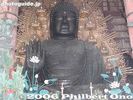
Jan 22, 2006
|
|

Jan 22, 2006
|
|
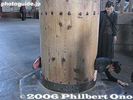
Crawl through a pillarJan 22, 2006
|
|

Jan 22, 2006
|
|

Jan 22, 2006
|
|

Jan 22, 2006
|
|

Jan 22, 2006
|
|

Rear viewJan 22, 2006
|
|

Todaiji TempleJan 22, 2006
|
|

Great BuddhaJan 22, 2006
|
|

Japan's largest Buddha statue in Todaiji. National Treasure.Jan 22, 2006
|
|
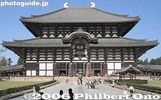
Todaiji TempleJan 22, 2006
|
|

Path to TodaijiJan 22, 2006
|
|

Gate godJan 22, 2006
|
|

Jan 22, 2006
|
|
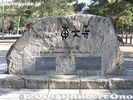
A World Heritage Site and one of Japan's most famous temples, Todaiji houses Japan's largest statue of the Buddha, a National Treasure. Temple was established about 1,200 years ago.Jan 22, 2006
|
|

Burn baby burn...The fire is put out by 9 pm. Unless you're near the fire, it can get very cold, so dress warmly for this festival.Jan 21, 2006
|
|

Jan 21, 2006
|
|

Jan 21, 2006
|
|

Bon fire burnsJan 21, 2006
|
|

Jan 21, 2006
|
|

The hill behind also starts to burn.Jan 21, 2006
|
|

Jan 21, 2006
|
|

Jan 21, 2006
|
|

Other torches are thrown in.Jan 21, 2006
|
|

Jan 21, 2006
|
|

Jan 21, 2006
|
|

Jan 21, 2006
|
|

Jan 21, 2006
|
|

Jan 21, 2006
|
|

The sacred torch lights the bonfire at around 6 pm.You can also see three lanterns for Todaiji Temple, Kasuga Taisha Shrine, and Kofukuji Temple. This is a joint festival between these three temples and shrine.Jan 21, 2006
|
|

The crowdJan 21, 2006
|
|

Ceremony at Nogami ShrineJan 21, 2006
|
|

FireworksJan 21, 2006
|
|

The sacred torch is brought.Jan 21, 2006
|
|

Volunteeer firemen and staff hike up the hills.Jan 21, 2006
|
|

Sacred torch arrives at the foot of the hill.The sacred torch is lit at Kasuga Taisha Shrine and brought to Nogami Shrine in a torch procession. It is a small shrine at the foot of the hill.Jan 21, 2006
|
|

Deer on the hillJan 21, 2006
|
|

Volunteer firement gather before going up the hill.The hill set alight by 300 volunteer firemen from all over Nara and prefectural workers who climb up the hill.Jan 21, 2006
|
|

Water bagsThe third item the volunteer firemen carry are water bags. The water bag is filled with water weighing 20 kg or so. A nozzle is also attached. It is used to extinguish the fire.Jan 21, 2006
|
|

Bon fire siteJan 21, 2006
|
|

Bamboo torchesThe bamboo torches is filled with kerosene and plugged with cotton cloth. They are used to set the hill afire. Jan 21, 2006
|
|

The deer have no idea what danger they are in...Jan 21, 2006
|
|

Bamboo torches and bamboo broomsThe bamboo torches is filled with kerosene and plugged with cotton cloth. They are used to set the hill afire. The bamboo brooms are used to spread the fire or extinguish it. The brooms burn up by the end of the festival.Jan 21, 2006
|
|

Bamboo torches and bamboo broomsThe bamboo torches is filled with kerosene and plugged with cotton cloth. They are used to set the hill afire. The bamboo brooms are used to spread the fire or extinguish it. The brooms burn up by the end of the festival.Jan 21, 2006
|
|

Dry grass ready to burn...Jan 21, 2006
|
|

Volunteer firemenThe hill set alight by 300 volunteer firemen and prefectural workers who climb up the hill.Jan 21, 2006
|
|

On the Sunday before the second Monday of Jan., 33 hectares of a hill called Wakakusa-yama (seen in the distance here) next to Nara Park is burned at night.The burning hill looks more spectacular from afar, but we went up close.Jan 21, 2006
|
|

Wakakusa-yama hill in JanuaryWakakusa-yama hill actually has three hills. We see only the first one here.Jan 21, 2006
|
|
|
|
|